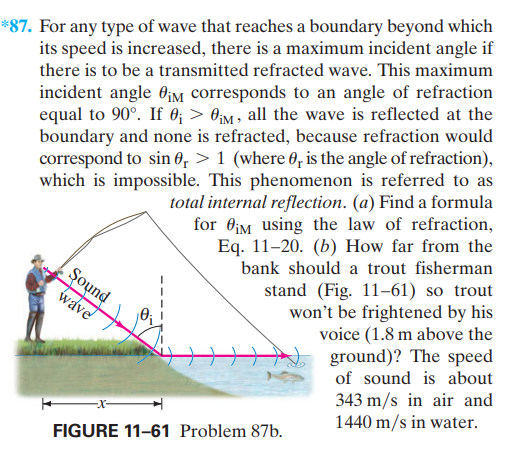*87. For any type of wave that reaches a boundary beyond which its speed is increased, there is a maximum incident angle if incident angle 0¡M corresponds to an angle of refraction equal to 90°. If 0; > Oim , all the wave is reflected at the boundary and none is refracted, because refraction would correspond to sin 0, > 1 (where 0, is the angle of refraction), which is impossible. This phenomenon is referred to as total internal reflection. (a) Find a formula for 0jM using the law of refraction, Eq. 11-20. (b) How far from the there is to be a transmitted refracted wave. This maximum bank should a trout fisherman Şound wave stand (Fig. 11–61) so trout won't be frightened by his voice (1.8 m above the ground)? The speed of sound is about 343 m/s in air and 1440 m/s in water. FIGURE 11-61 Problem 87b.
*87. For any type of wave that reaches a boundary beyond which its speed is increased, there is a maximum incident angle if incident angle 0¡M corresponds to an angle of refraction equal to 90°. If 0; > Oim , all the wave is reflected at the boundary and none is refracted, because refraction would correspond to sin 0, > 1 (where 0, is the angle of refraction), which is impossible. This phenomenon is referred to as total internal reflection. (a) Find a formula for 0jM using the law of refraction, Eq. 11-20. (b) How far from the there is to be a transmitted refracted wave. This maximum bank should a trout fisherman Şound wave stand (Fig. 11–61) so trout won't be frightened by his voice (1.8 m above the ground)? The speed of sound is about 343 m/s in air and 1440 m/s in water. FIGURE 11-61 Problem 87b.
University Physics Volume 1
18th Edition
ISBN:9781938168277
Author:William Moebs, Samuel J. Ling, Jeff Sanny
Publisher:William Moebs, Samuel J. Ling, Jeff Sanny
Chapter17: Sound
Section: Chapter Questions
Problem 71P: Sound is more effectively transmitted into a stethoscope by direct contact rather than through the...
Related questions
Question

Transcribed Image Text:*87. For any type of wave that reaches a boundary beyond which
its speed is increased, there is a maximum incident angle if
incident angle 0¡M corresponds to an angle of refraction
equal to 90°. If 0; > Oim , all the wave is reflected at the
boundary and none is refracted, because refraction would
correspond to sin 0, > 1 (where 0, is the angle of refraction),
which is impossible. This phenomenon is referred to as
total internal reflection. (a) Find a formula
for 0jM using the law of refraction,
Eq. 11-20. (b) How far from the
there is to be a transmitted refracted wave. This maximum
bank should a trout fisherman
Şound
wave
stand (Fig. 11–61) so trout
won't be frightened by his
voice (1.8 m above the
ground)? The speed
of sound is about
343 m/s in air and
1440 m/s in water.
FIGURE 11-61 Problem 87b.
Expert Solution
This question has been solved!
Explore an expertly crafted, step-by-step solution for a thorough understanding of key concepts.
This is a popular solution!
Trending now
This is a popular solution!
Step by step
Solved in 6 steps with 8 images

Recommended textbooks for you

University Physics Volume 1
Physics
ISBN:
9781938168277
Author:
William Moebs, Samuel J. Ling, Jeff Sanny
Publisher:
OpenStax - Rice University

Principles of Physics: A Calculus-Based Text
Physics
ISBN:
9781133104261
Author:
Raymond A. Serway, John W. Jewett
Publisher:
Cengage Learning

University Physics Volume 3
Physics
ISBN:
9781938168185
Author:
William Moebs, Jeff Sanny
Publisher:
OpenStax

University Physics Volume 1
Physics
ISBN:
9781938168277
Author:
William Moebs, Samuel J. Ling, Jeff Sanny
Publisher:
OpenStax - Rice University

Principles of Physics: A Calculus-Based Text
Physics
ISBN:
9781133104261
Author:
Raymond A. Serway, John W. Jewett
Publisher:
Cengage Learning

University Physics Volume 3
Physics
ISBN:
9781938168185
Author:
William Moebs, Jeff Sanny
Publisher:
OpenStax

College Physics
Physics
ISBN:
9781938168000
Author:
Paul Peter Urone, Roger Hinrichs
Publisher:
OpenStax College


Physics for Scientists and Engineers, Technology …
Physics
ISBN:
9781305116399
Author:
Raymond A. Serway, John W. Jewett
Publisher:
Cengage Learning